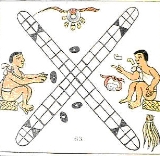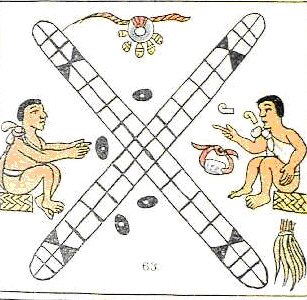
Patolli
Encyclopedia

Spanish language
Spanish , also known as Castilian , is a Romance language in the Ibero-Romance group that evolved from several languages and dialects in central-northern Iberia around the 9th century and gradually spread with the expansion of the Kingdom of Castile into central and southern Iberia during the...
form) is one of the oldest game
Game
A game is structured playing, usually undertaken for enjoyment and sometimes used as an educational tool. Games are distinct from work, which is usually carried out for remuneration, and from art, which is more often an expression of aesthetic or ideological elements...
s in America. It was very much a game of commoners and nobles alike and it was reported by the conquistador
Conquistador
Conquistadors were Spanish soldiers, explorers, and adventurers who brought much of the Americas under the control of Spain in the 15th to 16th centuries, following Europe's discovery of the New World by Christopher Columbus in 1492...
s that Montezuma
Moctezuma II
Moctezuma , also known by a number of variant spellings including Montezuma, Moteuczoma, Motecuhzoma and referred to in full by early Nahuatl texts as Motecuhzoma Xocoyotzin, was the ninth tlatoani or ruler of Tenochtitlan, reigning from 1502 to 1520...
often enjoyed watching his nobles play the game at court.
History
Patolli (or variants of it) was played by a wide range of pre-ColumbianPre-Columbian
The pre-Columbian era incorporates all period subdivisions in the history and prehistory of the Americas before the appearance of significant European influences on the American continents, spanning the time of the original settlement in the Upper Paleolithic period to European colonization during...
Mesoamerica
Mesoamerica
Mesoamerica is a region and culture area in the Americas, extending approximately from central Mexico to Belize, Guatemala, El Salvador, Honduras, Nicaragua, and Costa Rica, within which a number of pre-Columbian societies flourished before the Spanish colonization of the Americas in the 15th and...
n cultures and known all over Mesoamerica: the Teotihuacanos (the builders of Teotihuacan
Teotihuacán
Teotihuacan – also written Teotihuacán, with a Spanish orthographic accent on the last syllable – is an enormous archaeological site in the Basin of Mexico, just 30 miles northeast of Mexico City, containing some of the largest pyramidal structures built in the pre-Columbian Americas...
, ca. 200 BC - 650 AD) played it as well as the Toltec
Toltec
The Toltec culture is an archaeological Mesoamerican culture that dominated a state centered in Tula, Hidalgo in the early post-classic period of Mesoamerican chronology...
s (ca. 750 - 1000), the inhabitants of Chichen Itza
Chichen Itza
Chichen Itza is a large pre-Columbian archaeological site built by the Maya civilization located in the northern center of the Yucatán Peninsula, in the Municipality of Tinúm, Yucatán state, present-day Mexico....
(founded by refugee Toltec nobles, ca. 1100 - 1300), the Aztec
Aztec
The Aztec people were certain ethnic groups of central Mexico, particularly those groups who spoke the Nahuatl language and who dominated large parts of Mesoamerica in the 14th, 15th and 16th centuries, a period referred to as the late post-classic period in Mesoamerican chronology.Aztec is the...
s (who claimed Toltec descent, 1168 - 1521), and all of the people they conquered (practically all of Mesoamerica, including the Zaptotecs and the Mixtec
Mixtec
The Mixtec are indigenous Mesoamerican peoples inhabiting the Mexican states of Oaxaca, Guerrero and Puebla in a region known as La Mixteca. The Mixtecan languages form an important branch of the Otomanguean language family....
s). The ancient Mayans also played a version of Patolli.
Players
Patolli is a race/war game with a heavy focus on gambling. Players would meet and inspect the items each other had available to gamble. They bet blankets, Maguey plants, precious stones, gold adornments, food or just about anything. In extreme cases, they would bet their homes and sometimes their family and freedom. Agreeing to play against someone was not done casually as the winner of the game would ultimately win all of the opponent's store of offerings. Each player must have the same number of items to bet at the beginning of the game. The ideal number of items to bet is six, although any number would be acceptable as long as each player agreed. The reason for having at least six bits of treasure is because there are six jade markers that will traverse the game board. As each marker successfully completes the circuit around the board, the opponent is required to hand over ownership of an item from his or her treasure.Once an agreement is made to play, the players prepare themselves by invoking the god of games, Macuilxochitl
Xochipilli
thumb|300px|right| Image of Xochipilli.Xochipilli was the god of art, games, beauty, dance, flowers, and song in Aztec mythology. His name contains the Nahuatl words xochitl and pilli , and hence means "flower prince"...
, by offering incense, prayers and food. After psyching themselves up - the game begins.
Gameplay and Game Pieces
The object of the game is for a player to win all of the opponent's treasure. To do this, the players may need to play more than one round of the game. In order to complete a round, a player needs to get all of the six jade markers from the starting queue position to the ending square position on the game board before the other player. Some markers that could be used were beans, or kernels of maize.The jade stone markers come in two colors. One player would have an assortment of red colored jade markers. The other player would have an assortment of blue colored jade markers.
In order to get one of the jade stone markers on the board, the player tosses five specially prepared kidney beans on the game area. The kidney beans, or patolli, has one side marked with a white dot. Thus tossing the patolli would result in several patolli showing this white mark and others showing a blank side. In order to get on the game board, one patolli would have to land with the white mark face up and all the others face down (getting a score of one). The players take turns tossing. Once a player is able to get on the board, the game begins and the player is allowed to place one of the jade markers from the queue onto the starting square of the game board.
The game board is shaped like a capital letter X that has square and triangular shaped landing positions marked on it that run down one side and back up the other side of the X. There are 52 landing positions in all. The game board could be drawn on a bit of leather or on a straw mat and decorated with colored dye or it could also be carved into the floor or table top.
The four landing positions in the middle of the X is a special area. For instance, a player can kick the opponent jade off of the game board and back into the opponent starting queue if the player should 'land' a jade on the opponent jade in this area. The opponent would then be required to transfer ownership of one of the items being bet at this time.
Another special area is marked by two darker triangular shapes near the end of each arm of the X. If a player should land a jade inside one of these triangular areas, the player would be required to transfer ownership of an item to the opponent.
There are two special square marks at the end of each arm of the X. Any player who lands on one of these squares is required to roll the patolli and take another turn.
After a player has a jade on the game board, the player must move one of the jade markers the same number of times as there are white dots showing from the toss. If the player cannot move because he would overshoot the ending square or land on an occupied spot, then he loses the turn.
If the toss shows five white dots, then the player must choose one jade marker to move ten spaces.
Macuilxochitl
Xochipilli
thumb|300px|right| Image of Xochipilli.Xochipilli was the god of art, games, beauty, dance, flowers, and song in Aztec mythology. His name contains the Nahuatl words xochitl and pilli , and hence means "flower prince"...
is also playing the game. The Magliabechiano codex says: Patolli's god was Macuilxochitl
Xochipilli
thumb|300px|right| Image of Xochipilli.Xochipilli was the god of art, games, beauty, dance, flowers, and song in Aztec mythology. His name contains the Nahuatl words xochitl and pilli , and hence means "flower prince"...
, deity of music, dance, gambling and games, called God of the Five Flowers. Players are required to give Macuilxochitl an item if a toss of the patolli result in no white dots (all blank sides) showing. A space is reserved above the game board for these items. The winner of the round will receive the treasure located in this space as a gift from Macuilxochitl.
Spanish Conquest
The Spanish priests forbade the game during the Spanish conquest of MexicoSpanish conquest of Mexico
The Spanish conquest of the Aztec Empire was one of the most important campaigns in the Spanish colonization of the Americas. The invasion began in February 1519 and was acclaimed victorious on August 13, 1521, by a coalition army of Spanish conquistadors and Tlaxcalan warriors led by Hernán Cortés...
and were known to have burned the hands of people caught playing the game.

